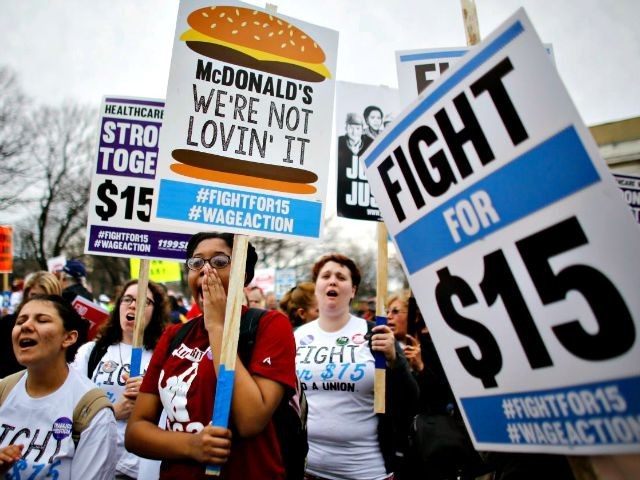Business Insider reporter Hollis Johnson says that “The age of the restaurant self-service kiosks has dawned, and it’s the end of fast food as we know it.”
Johnson rattles off several fast food restaurant chains that have now opted to install self-service kiosks, just as “Fight for $15” – a far-left protest movement, pushing for minimum wage hikes up to $15 per hour – intimidates state lawmakers to pass legislation that raises wages for low-skilled fast food workers.
Indeed, last week, Wendy’s fast food restaurant chain announced plans to offer self-serving kiosks at its 6,000-plus locations across America, making them available to costumers by the end of 2016.
Last February, McDonald’s rolled out its “Create Your Taste” touchscreen kiosks, which allow customers to customize their own meals and burgers.
Panera Bread was among America’s first food service outlets to head down the path of lower labor costs and service efficiency that self-serving kiosks provide. Panera unveiled its “Panera 2.0” initiative in April 2014. At the time, roughly half of the company-owned stores were equipped with the new self-serve technology. The company, like its competitors, planned to expand the devices to its remaining locations by the end of 2014.
Before Panera Bread, Chili’s Grill & Bar began testing tablets that allow diners to order beverages and desserts and pay their entire bill, free from the struggle of having to flag down a server. An initial 180 tablets in a handful of Chili’s restaurants, soon ballooned into 45,000 tablets across 823 Chili’s restaurants. The restaurant’s executives called it “the largest rollout of tabletop tablets in the U.S.”
Last March, Breitbart News reported that Carl’s Jr. and Hardee’s restaurant chain CEO Andy Pudzer said he has plans to fully embrace automated machines.
“We could have a restaurant that’s focused on all-natural products and is much like an Eatsa, where you order on a kiosk, you pay with a credit or debit card, your order pops up, and you never see a person,” Pudzer said after visiting a fully automated restaurant named Eatsa.
A completely employee-free restaurant, Pudzer said, is a business decision spurred on by disproportionate minimum wage hikes.
“With government driving up the cost of labor, it’s driving down the number of jobs,” he said. “You’re going to see automation not just in airports and grocery stores, but in restaurants as well.”
Echoing Pudzer, Wendy’s CFO Todd Penegor told a handful of investors that mandated wage hikes will cause his company to pursue other innovative avenues that could lead to fewer jobs for low-skill workers.
“We continue to look at initiatives and how we work to offset any impacts of future wage inflation through technology initiatives, whether that’s customer self-order kiosks, whether that’s automating more in the back of the house in the restaurant,” Penegor said, adding that “you’ll see a lot more coming on that front later this year from us.”
Wendy’s CEO Emil Brolick reiterated Penegor, saying, “You know there are some people out there who naively say that these wages can simply be passed along in terms of price increases,” Brolick said last August. “I don’t think that the average franchisee believes that.”
Business Insider‘s Hollis Johnson asks if 2016 is “the last stand of the fast-food worker?”
“Perhaps not,” Johnson notes. “But as automation and self-service kiosks develop, the way the fast-food industry manages and utilizes human labor will change drastically.”
Follow Jerome Hudson on Twitter @jeromeehudson.

COMMENTS
Please let us know if you're having issues with commenting.